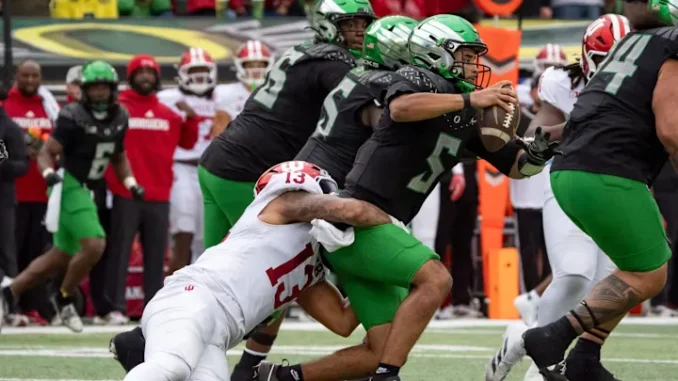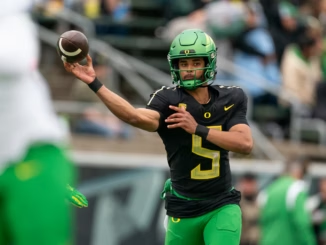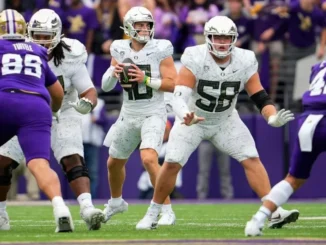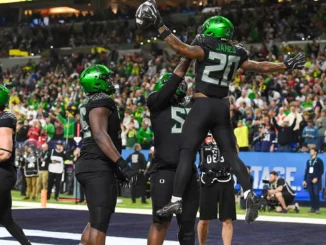
Autzen Stadium felt like a coronation until the scoreboard told a different story. Indiana’s 30-20 upset didn’t just flip a result — it changed the arithmetic of playoff viability. A midseason loss doesn’t erase talent or cancel a résumé, but it does shrink the margin for error. It alters how models weigh future results and forces a program to prove consistency where comfort once existed.
Oregon didn’t lose its season in one night, but its cushion took a hit. Projection models that once gave the Ducks a comfortable percentile in playoff probability shifted after Indiana’s win, and the polls followed. Those measurable changes matter because playoff selection is as much about probability and context as it is about headline victories.
Resume Damage: How One Loss Moves the Math
Predictive tools and voters react instantly when a result contradicts prior assumptions. Before the Indiana game, Oregon sat comfortably among ESPN’s top playoff contenders, ranked high in both FPI and the Allstate Playoff Predictor. After the upset, those projections dropped noticeably. The AP Top 25 moved the Ducks from the top three to the lower end of the top ten, and FPI slid them several slots.
Those aren’t cosmetic shifts. In simulation models, even small drops reduce the number of playoff scenarios where a second stumble is survivable. Algorithms treat midseason defeats as increased variance in future outcomes, while human voters adjust narratives accordingly.
A loss to a mid-tier Big Ten team removes a résumé anchor and forces every remaining game to carry more weight in tiebreakers and committee comparisons. Oregon’s path isn’t gone — but it now requires conviction, not just victory. Strength-of-schedule math and head-to-head parity have been recomputed with the loss baked in. To regain its cushion, Oregon must win convincingly against quality opponents.
Film Fault Lines: What the Tape Revealed
Numbers explain what happened; film shows how. Indiana held Oregon to 267 total yards and forced two turnovers, neutralizing tempo and deep shots with disciplined pressure and sturdy run fits.
Three tactical issues stand out:
1. Pass Protection.
Indiana’s inside stunts and delayed pressures repeatedly collapsed the pocket, forcing Dante Moore into hurried throws and off-platform decisions.
2. Red-Zone Execution.
When space tightened, Oregon settled for field goals instead of touchdowns. A few stalled possessions proved decisive in a ten-point loss.
3. Situational Football.
Special-teams miscues and late clock-management errors flipped field position at critical moments.
One third-quarter sequence summed it up: an interior slide missed a delayed blitz, Moore had to throw the ball away, and the field flipped. On paper, it’s one play. On tape, it’s a symptom of systemic strain — the kind that projection models interpret as volatility in future performance.
Scenario Math: How the Path Widens Again
Narrowed is not closed. The Allstate Playoff Predictor still shows plausible routes for Oregon to recover, but the odds are now conditional. After Week 7, ESPN listed the Ducks around the mid-60s percentile for playoff probability — down from top-tier status a week earlier. Indiana’s win, conversely, vaulted the Hoosiers into an upper projection band, a reminder of how one shock result can reshape the board overnight.
Oregon’s cleanest route back is simple and brutal: win out, and do it impressively. Projection models reward streaks of decisive victories against ranked opponents. Consecutive quality wins will shrink measured variance and restore Oregon to a higher projection tier.
The alternative path — splitting games and hoping others falter — relies on external chaos and sits at low probability. Before the loss, Oregon’s profile allowed a single slip; now, another would be fatal to at-large chances. That’s the statistical line between being a favorite and being a contender on life support.
The Fix: Surgical and Unspectacular
The solutions are direct, if difficult.
Protect the pocket. Employ quicker releases, cleaner slide protection, and play designs that avoid long-yardage downs.
Finish drives. Sharpen red-zone sequencing and improve blocking fundamentals from tight ends and backs.
Win situational moments. Tighten special-teams coverage, manage the clock cleanly, and stay disciplined on fourth downs.
None of these are flashy fixes, but they directly improve expected points per drive — the stat that quietly underpins every playoff model.
Culture matters, too. The staff must project accountability and communicate corrections clearly. Voters and models respond to evidence, not narrative. A stretch of efficient, mistake-free football will move metrics faster than any press quote.
Conclusion
Indiana’s upset did measurable damage to Oregon’s playoff cushion. ESPN’s post-Week 7 projections dropped the Ducks well out of the safest tier, and multiple analytics outlets now list them outside the unquestioned top group of CFP favorites. Indiana’s defensive performance — holding Oregon to 267 yards and flipping field position on key drives — created the kind of result that algorithms and committees penalize heavily.
Before the loss, Oregon could afford a slip. Now, perfection is the price of admission. The path back requires clean, decisive wins that rebuild confidence in both models and minds. The Ducks still control that lever — but without a safety net. If they respond with the precision and discipline that playoff teams display, the path will widen again. If not, this will be remembered not as a blip, but as the hinge on which their season turned.



